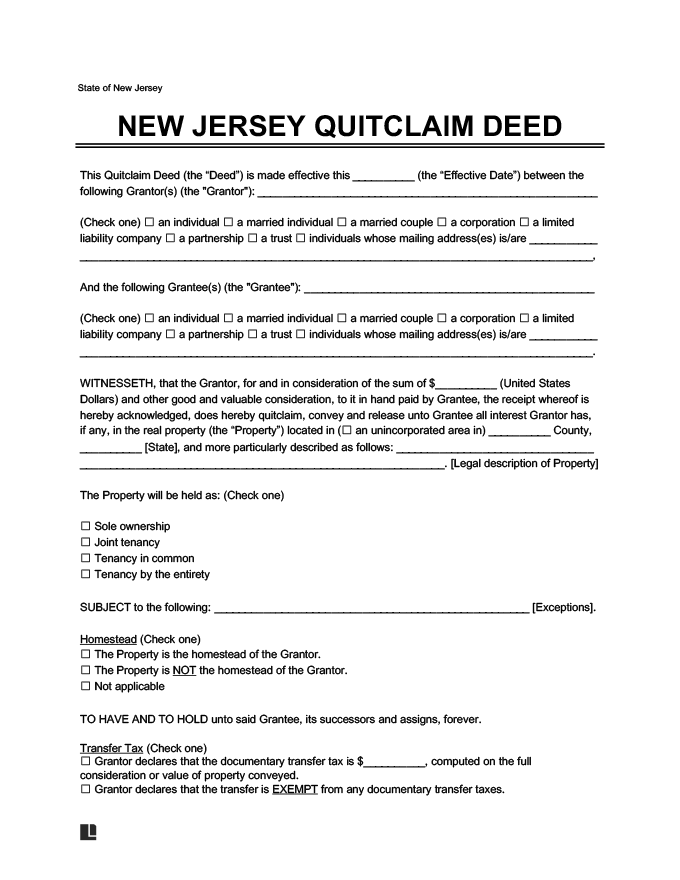When you need a faster solution for a property transfer that does not have a warranty attached, a quitclaim deed could be the ideal option for your needs. A quitclaim deed in New Jersey transfers property from one party to another without a warranty for liens or encumbrances on the property.
It is often used for property transfers between individuals who know one another: for example, a property transfer between parent and child or adding a spouse to the deed following marriage.
Statute and Requirements
- J. Stat. § 46:5-1 to 46:5-6 covers the legal requirements of a quitclaim deed. It notes that there is specific language that should be used in a quitclaim deed: notably, “the grantor releases to the said grantee” or “the grantor does remise, release, and forever quitclaim unto the said grantee,” or “the grantor does grant and release to the said grantee.”
Signing
- J. Stat. § 46:14 requires a quitclaim deed to be signed by the grantors and notarized.
Transfer Tax
New Jersey has a complex real estate transfer fee structure that should be carefully considered when transferring property, including property transferred through a quitclaim deed.
Additional Documents
Several additional documents may need to be prepared along with the quitclaim deed form.
- Form RTF-1 for tax exemptions
- RTF-1EE for real estate transfers in which the consideration is over $1,000,000
- Form GIT/REP-1 for non-resident sellers, unless they have exemptions
Filing
A quitclaim deed should be filed at the county clerk’s office where the property is located.
Validity Requirements
A valid quitclaim deed in New Jersey will need to contain several essential elements. To distinguish it from other types of property transfers and deeds, it should not include warranties or covenants related to the title on the property, since quitclaim deeds do not have warranties. To be valid, it may need to meet several clear guidelines.
Legal Description
A New Jersey quitclaim deed must include a legal description of the property — not just the property’s address, but the description included in the title. The legal description helps designate the boundaries of the property.
Statement of Consideration
The statement of consideration includes any goods or funds exchanged for the property. Some properties exchanged using a quitclaim deed may be transferred for no monetary value, as in the case of a transfer between parents and child or adding a spouse to the property. This should be stated in the document.
Contact Information for All Parties
A valid quitclaim deed needs to contain the name and address of the grantor and the name of the grantee. The document should also include the name and address of the person who prepared the deed.
Notarization
A notarized quitclaim deed establishes the validity of the document and shows that it was witnessed by the notary. It should also contain the signature of the grantor.
Quitclaim Deeds vs. Other Property Transfer Methods
In New Jersey, property owners have several options for the legal transfer of properties.
| Quitclaim Deed | A real estate transfer method without title warranties accelerates transactions like adding or removing a spouse post-marriage or divorce, transferring property among relatives, and some commercial dealings. It ensures quicker real estate transfers but lacks title protection for the new owner, exposing them to potential title issues without guarantees. |
| Bargain-and-Sale Deed with Covenant | This real estate transfer method, often used in New Jersey, includes a covenant promising that the current owner has not altered the property's title and is unaware of any third-party claims. It offers the new buyer protection against issues caused by the current owner's actions but does not cover problems existing before the current owner's tenure or those arising from third-party actions. |
| Special Warranty Deed | offers more protection than quitclaim or bargain-and-sale deeds by having the current owner back the title and defend the new owner against claims related to their period of ownership. Common in foreclosures and bank sales, it protects more than simpler deed types but doesn't cover the grantor for liens or encumbrances prior to their ownership, leaving the new owner with some potential risk. |
| General Warranty Deed | This standard real estate transfer method includes a full warranty, with the current owner guaranteeing a clear title except for specified exceptions. It's the norm for standard real estate sales, providing the highest level of buyer protection. However, this method might require more time than other deed transfers, owing to the necessary property discovery process. |
| Life Estate Deed | Creates dual ownership interests in a property: a life interest for the current tenant to live in and use the property for their lifetime, and a remainder interest for a beneficiary to gain possession post-death. Often utilized when a property is bought with the stipulation that the seller remains a tenant until death, it ensures the property's eventual transfer but requires the beneficiary's consent for full title transfers. Irrevocable by the current owner, it offers no protection to the beneficiary against damage by the tenant. |
| Survivorship Deed Form | Automatically transfers property ownership to a surviving co-owner upon one owner's death, ensuring seamless transition without probate. This method keeps the property within co-ownership, circumventing probate challenges but offers no protection against existing liens or encumbrances. |
